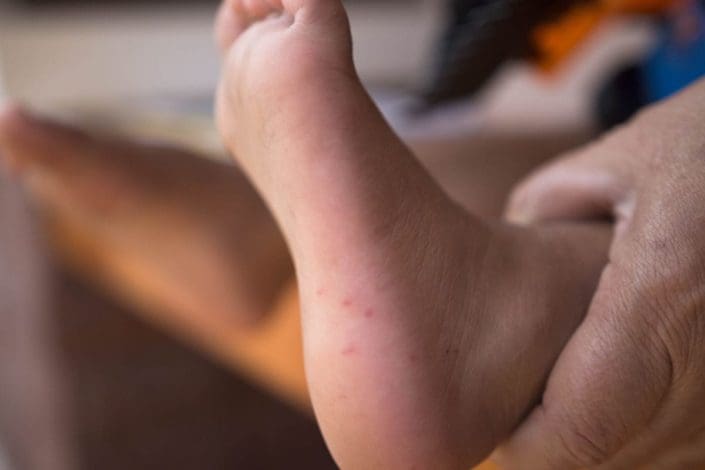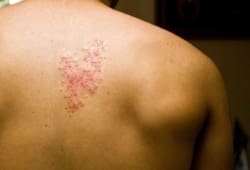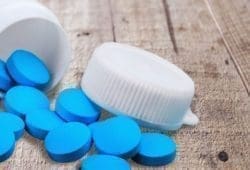
What is hand, foot, and mouth disease?
Hand, foot, and mouth disease (HFMD) is a common childhood illness. It is caused by a virus and is very contagious, but not severe. The disease is easy to spot because of its symptoms: sores or blisters inside and outside the mouth as well as a rash (red spots) or sores on the palms of the hands and soles of the feet. Infants and children younger than age 5 are most likely to get the virus. But older children, teens, and adults can get it, too. A mild outbreak of the disease commonly occurs during summer and early fall. This disease shouldn’t be confused with foot-and-mouth disease, which affects sheep, cattle, and pigs.
Symptoms of hand, foot, and mouth disease
The common symptoms of hand, foot, and mouth disease are:
- Painful sores or blisters around or in the mouth (cheeks, gums, and throat)
- Rash of flat red spots on the palms of the hands and the soles of the feet. These mildly painful spots may turn into blisters and can sometimes spread to the knees, elbows, bottom, or genital areas.
- Fever (which can be high)
- Headache
- Feeling unwell or overly tired
- Poor appetite
- Sore throat
These symptoms don’t usually appear all at once, but in stages. Your child may not have every symptom. Some people, especially adults, get the disease and don’t show any symptoms. They can still pass it on to others.
Symptoms usually appear 3 to 7 days after coming into contact with someone with the disease. Further symptoms can develop from complications. Because the sores make it painful to swallow, children and adults can become dehydrated. High fevers can cause seizures.
What causes hand, foot, and mouth disease?
HFMD is caused by either coxsackieviruses or human enteroviruses. It is found in the digestive tract, including the mouth, esophagus, stomach, small intestine, large intestine, rectum, and anus.
The virus spreads when a sick person sneezes, coughs, or blows their nose. You can get it if you touch your nose, eyes, or mouth after touching something contaminated with the virus, such as a toy. You can also get it if you touch the stool (poop) or blisters of a person who is infected.
How is hand, foot, and mouth disease diagnosed?
Your child’s doctor will review signs of illness and examine your child’s sores or blisters to diagnose HFMD. In some cases, you child’s doctor may swab the back of your child’s throat to send to a lab. They may ask you to collect a stool sample from your child to send to a lab. The lab can test for the virus and rule out other possible causes of the symptoms.
Can hand, foot, and mouth disease be prevented or avoided?
HFMD is contagious. It’s important to avoid contact with anyone who has it. You won’t always know when another person has the virus, especially in the early stages. Make sure you and your child practice good hygiene:
- Wash your hands often and well with soap and water.
- Encourage your child to cover their mouth and nose when they sneeze.
- Try not to touch your eyes, nose, or mouth, especially with unwashed hands.
- Disinfect surfaces that are frequently touched, such as doorknobs or toys, especially if someone is sick.
Hand, foot, and mouth disease treatment
There is no cure for HFMD. Antibiotics won’t work since it’s caused by a virus. Treatment focuses on relieving symptoms.
Your doctor may recommend tips to relieve your child’s discomfort:
- Take over-the-counter pain relievers to treat fever and sore throat. These could include acetaminophen (one brand name: Tylenol) or ibuprofen (one brand name: Advil). Check the back of the box or ask your doctor about dosage directions. Don’t give a child under 18 years old aspirin for pain. Aspirin has been linked to Reye’s syndrome, a rare but serious condition that can be deadly without early treatment.
- Gargle with salt water to relieve sore throat pain. Combine ½ teaspoon salt with 1 glass of warm water and stir.
- Get plenty of fluids. Water, cold milk products, or Pedialyte are best. Avoid juice and soda which can burn or irritate mouth sores. If your child is having difficulty swallowing, try giving them non-juice popsicles.
Living with hand, foot, and mouth disease
Symptoms of HFMD often go away on their own. As a parent caring for a child who has the virus, your primary goals are to keep your child hydrated and rested. You should keep your child at home to avoid spreading it to other people. Your child should fully recover in 5 to 7 days. Contact your child’s doctor if symptoms continue or worsen.
There is currently no vaccine in the United States to protect against the viruses that cause HFMD, according to the Centers for Disease Control and Prevention (CDC). However, research is underway to develop a vaccine to help prevent the disease in the future.
Questions to ask your doctor
- How long is my child contagious?
- Does the virus spread by touching infected sores or blisters?
- Can you apply an ointment to the sores to relieve the pain?
- Do the sores or blisters leave long-term scars?
- Do the sores inside your mouth take longer to heal than the sores on your hands and feet?
- My child has HFMD. Do I need to stay home from work, too?
Resources
Centers for Disease Control and Prevention: Hand, Foot, and Mouth Disease
National Institutes of Health, MedlinePlus: Hand-Foot-Mouth Disease
![]()
Copyright © American Academy of Family Physicians
This information provides a general overview and may not apply to everyone. Talk to your family doctor to find out if this information applies to you and to get more information on this subject.








